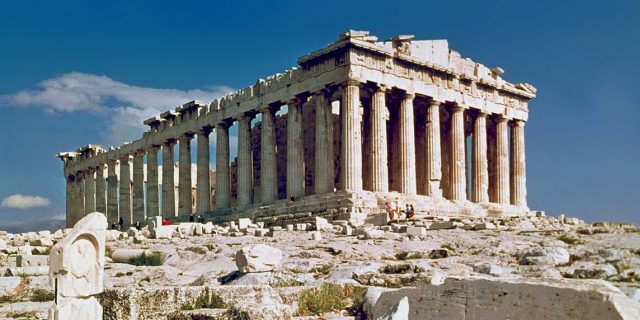The Temple of Poseidon is an ancient Greek temple on Cape Sounion, Greece, dedicated to the god Poseidon. There is evidence of the establishment of sanctuaries on the cape from as early as the 11th century BC. Sounion's most prominent temples, the Temple of Athena and the Temple of Poseidon, are however not believed to have been built until about 700 BC, and their kouroi (freestanding Greek statues of young men) date from about one hundred years later. The material and size of the offerings at the Temple of Poseidon indicate that it was likely frequented by members of the elite and the aristocratic class.
The Greeks considered Poseidon to be the "master of the sea". Given the importance to Athens of trade by sea and the significance of its navy in its creation and survival during the fifth century, Poseidon was of a particular relevance and value to the Athenians.
 1887 depiction
1887 depictionThe original, Archaic-period temple of Poseidon on the site, which was built of tufa, was probably destroyed in 480 BCE by Persian troops during Xerxes I's invasion of Greece. Although there is no direct evidence for Sounion, Xerxes certainly had the temple of Athena, and everything else on the Acropolis of Athens, razed as punishment for the Athenians' defiance.[1] After they defeated Xerxes in the naval Battle of Salamis, the Athenians placed an entire captured enemy trireme (warship with three banks of oars) at Sounion as a trophy dedicated to Poseidon.[2]
PlacementThe temple of Poseidon at Sounion was constructed from 444 to 440 BCE. This was during the ascendancy of the Athenian statesman Pericles, who also rebuilt the Parthenon in Athens. The temple of Poseidon was built on the ruins of a temple dating from the Archaic period, about which the Greek geographer Strabo noted: "Geraistos [in Euboia] . . . is conveniently situated for those who are sailing across from Asia to Attica since it is near Sounion. It has a sanctuary (hieron) of Poseidon, the most notable of those in that part of the world, and also a noteworthy settlement."[3]
The Greeks often chose temple locations that were physically related to or suggestive of the deity honored in the temples. Peak sanctuaries, for example, were often dedicated to Zeus, the god of the heavens and weather.[4]
The choice of location was however also often influenced by practical considerations. According to the authors of Ancient Greece – Temples and Sanctuaries, the decision to build the temple at Sounion is clearly related to the visibility of the sea lanes to and from Piraeus, which provided the first and final vantage points from which incoming and exiting ships could be seen.[4] The Cape of Sounion can be found on the coast of the Myrtoan Sea in the southern part of Greece.
Jessica Paga and Margaret M. Miles argue that the most plausible explanation for the location of the temple was connected with the increasing strength and prominence of the Athenian navy. Coupled with the ongoing conflict of Athens with the islanders of Aegina was the threat to Athens from the Boeotians and Chalkidians in 506/5 BCE. The placement of the temple can be seen as serving both military and economic strategies. Cape Sounion, the most southern part of Attica, witnessed a lot of mercantile naval traffic. A temple there could also have served the purpose of surveillance for potential enemy attacks.[5] According to archaeologists from the University of Vienna's Institute of Classical Archeology, the degree of access or accessibility of Sounion itself for Athenians and members of the cult of Poseidon from other demes remains unclear.[6]
ConstructionSecured by its own peribolos (court enclosed by a wall), propylaea (gateway), and two stoas (covered walkways or porticos), the construction of the ancient Temple of Poseidon around 490 BCE was likely a large investment made by the state of Athens. Between 508/7 and 480/79 BCE Athens is believed to have supported the founding and expansion of several sanctuaries in Attica, including those at Rhamnous, Mounychia in Piraeus, and Eleusis.[7]
As already explained above, one reason for the construction of the temple may have been militarily important and strategic location of the temple. Following the battle with the Persians at Marathon, the Athenians were weak and were vulnerable to a naval strike. Athens at the time faced nearby enemies, like the island of Aigina, that could have taken advantage of Athen's recovering army by attacking by sea. Therefore, Athens needed a lookout, for which Cape Sounion was the perfect place because anyone traveling by the coast of Attica needed to go around Cape Sounion. So construction of the temple right beside the water was a military tactic that secured an outpost in a highly trafficked area in order to keep tabs on the movements of enemies.[5]
Cult activityAs indicated by literary and archaeological evidence, the "leveled summit" on the coast of Cape Sounion was likely a cult site from as early as the end of the eighth century BCE. Two cult centers dedicated to Athena and Poseidon respectively are believed to have been established by 700 BCE.[7]




























Add new comment